- ● homepage
- ● archives
- ● restoration
- ● books
- ● big banners
- ● post board
- ■ neo's search
- ■ about us
- ■ 게재방법 안내
- 개인정보처리방침

- [email protected]
- Tel. 02_335_7922
- Fax. 02_335_7929
- 10:00am~04:30pm
- 월요일~금요일
- 3/3(월) 대체공휴일

38˚C
학고재 소장품 Hakgojae Collection展 2021_0106 ▶ 2021_0131
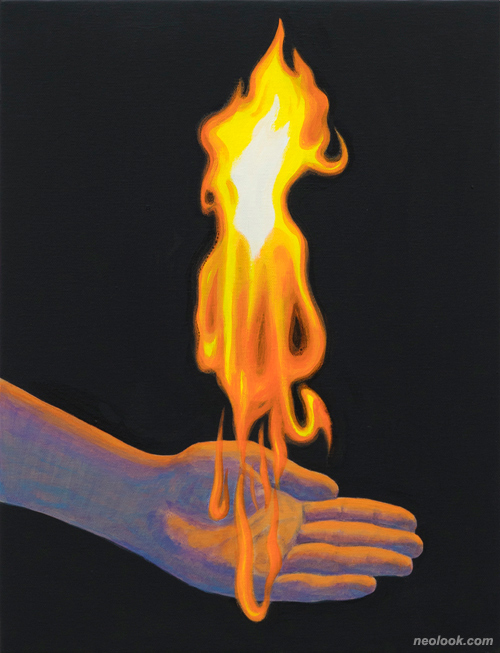
- 이우성_당신을 위해 준비했습니다_캔버스에 아크릴릭 과슈, 젯소_41×31.5cm_2017 LEE Woosung_My Dear_Acrylic gouache, gesso on canvas_41×31.5cm_2017
● 위 이미지를 클릭하면 학고재 오룸으로 갑니다.
별도의 초대일시가 없습니다.
기획 / 학고재_박미란
2021_0106 ▶ 2021_0131 참여작가 박광수 PARK Gwangsoo_아니쉬 카푸어 Anish KAPOOR 안드레아스 에릭슨 Andreas ERIKSSON_이안 다벤포트 Ian DAVENPORT 이우성 LEE Woosung_장재민 JANG Jaemin_주세페 페노네 Guiseppe PENONE 천원지 CHEN Wenji_팀 아이텔 Tim EITEL_허수영 HEO Suyoung 관람시간 / 10:00am~06:00pm / 월요일 휴관
학고재 본관 Hakgojae Gallery, Space 1 서울 종로구 삼청로 50 Tel. +82.(0)2.720.1524~6 www.hakgojae.com www.instagram.com/hakgojaegallery www.facebook.com/hakgojaegallery
온라인전시 / 2020_1201 ▶ 2021_0228 참여작가 강요배 KANG Yo-bae_김현식 KIM Hyunsik 박광수 PARK Gwangsoo_아니쉬 카푸어 Anish KAPOOR 안드레아스 에릭슨 Andreas ERIKSSON_이동엽 LEE Dong-youb 이안 다벤포트 Ian DAVENPORT_이우성 LEE Woosung 장재민 JANG Jaemin_주세페 페노네 Guiseppe PENONE 진 마이어슨 Jin MEYERSON_천원지 CHEN Wenji 팀 아이텔 Tim EITEL_허수영 HEO Suyoung
학고재 오룸 Hakgojae OROOM online.hakgojae.com
38℃ ● 인류가 아프다. 불현듯 등장한 전염병은 무서운 속도로 확산하며 이번 세기 초유의 팬데믹을 야기했다. 2020년의 디스토피아는 외계 생명체나 로봇, 어떠한 신화적 존재가 아닌 현실 세계의 작은 균으로부터 시작됐다. 유래는 명확하지 않으나 분명한 것은 이미 이 불청객이 우리가 겪어낼 세상의 일부가 되었다는 점이다. 질병 앞에서는 특권이 없다. 사람의 몸은 연약하여 낯선 균의 침투에 쉽게 달아오른다. 그래서 체온이 감염의 지표가 됐다. 고열의 기준점은 약 38℃, 이를 넘기면 공공장소의 출입이 제한된다. ● 온 세상 사람들이 몸에 주목한다. 지키기 위해 격리하고, 징후에 민감하게 반응한다. 물리적 활동이 제한되니 가상 현실이 팽창했다. 혼자 있는 시간이 늘어나면서 내면세계에 대한 관심도 커졌다. 각기 다른 가치를 바쁘게 좇던 우리는 모두 함께 멈추었다. 비로소 주위를 돌아본다. 위험한 체온 38℃는 사람이 가장 편안함을 느끼는 목욕물의 온도이기도 하다. 커다란 세상 속 작은 생명으로서 문득 겸손해진다. 도달할 수 없는 한도와 깊이로 인간의 몸을 품어온 환경을 떠올려본다. 이번 전시는 팬데믹 시대를 계기 삼아 인류와 세상의 관계를 새롭게 고민해 보기 위해서 마련한 자리다. 학고재 소장품을 중심으로 국내외 동시대 작가들의 작품을 몸, 정신, 물질, 자연이라는 네 가지 범주로 나누어 살펴본다.
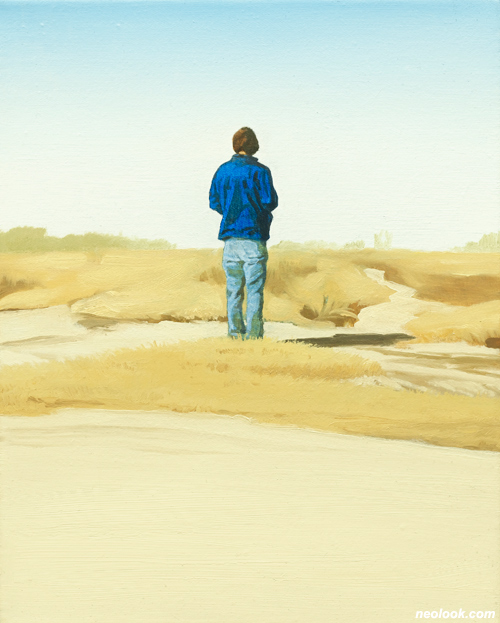
- 팀 아이텔_란다인바르츠 (업컨트리)_캔버스에 유채_25×20cm_2003 Tim EITEL_Landeinwarts (Upcountry)_Oil on canvas_25×20cm_2003
1. 몸 ● 이우성(b. 1983, 서울)은 자신이 몸담은 세대의 초상을 그린다. 화면 속 신체는 관점의 설정에 따라 개인과 사회의 범주를 유연하게 넘나든다. 진솔한 듯 은유적이고, 무던한 듯 집요하다. 「당신을 위해 준비했습니다」(2017)에 등장하는 불은 이우성의 초기 회화에서 주로 불안과 무력감을 드러내던 소재다. 꺼지지 않은 작은 불씨가 손바닥 안에 타오른다. ● 팀 아이텔(b. 1971, 독일 레온베르크)의 화면은 현대인의 고독과 소외를 투영한다. 기하학적 구조와 정제된 색채의 배경 속 이름 모를 인물들이 거닌다. 「스타디온 (아레나)」(2001)는 열두 개 캔버스로 구성한 작품이다. 각각의 화면이 빈 경기장을 비춘다. 양측 가장자리에 두 인물이 등장한다. 인물의 뒷짐진 손이 경기에 참여하려는 의지의 부재를 암시한다. 두려움일 수도, 혹은 방관일 수도 있다. 관객은 화면에 스스로의 서사를 비추어 본다. 여백이 사색의 여지를 연다.

- 아니쉬 카푸어_쿠비 시리즈_종이에 과슈_79×93cm_2006 Anish KAPOOR_Kubi Series _Gouache on paper_79×93cm_2006
2. 정신 ● 아니쉬 카푸어(b. 1954, 인도 뭄바이)의 「쿠비 시리즈」(2006)가 뿜어낸 유려한 붉은 선이 미지의 어둠을 향해 뻗어 나간다. 카푸어는 붉은색이 사람 내면의 핵심을 상징한다고 본다.(KAPOOR, Anish. In conversation with John Tusa. posted on Anish Kapoor's official website, 2003. Available at: http://anishkapoor.com/180/in-conversation-with-john-tusa-2) '쿠비'는 티베트 남서부 히말라야산맥 브라마푸트라 강의 원류를 가리키는 이름이다. 강은 발원지로부터 인도 아삼 지방을 지난 후 갠지스 강에 합류한다. 인간 사회 및 정신의 상호 연결성을 지형적 개념에 빗대어 추상화한 회화다. ● 주세페 페노네(b. 1947, 이탈리아 가레시오)는 이탈리아의 전위적 미술 운동 '아르테 포베라'의 중심인물이다. 나무와 숲 등을 매개체 삼아 내면세계를 탐구한다. 「번식」(1994)의 화면에 세 개의 지문이 보인다. 지문을 중심으로 그려 넣은 동심원의 형상이 생명의 파동을 은유한다.
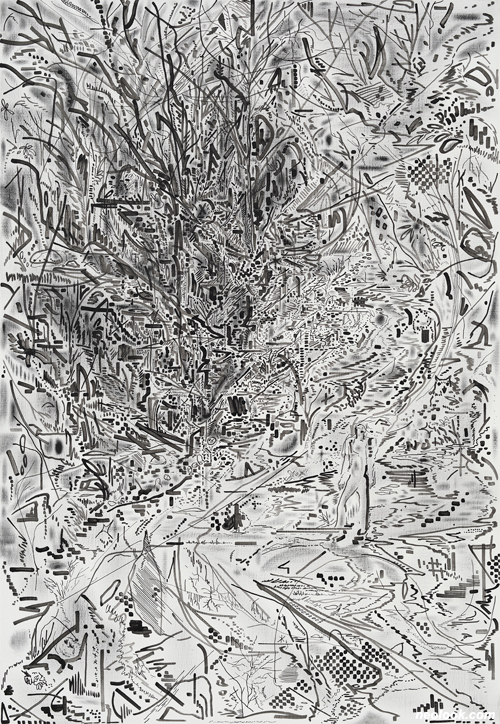
- 박광수_깊이 – 골짜기_캔버스에 아크릴채색_116.8×80.3cm_2019 PARK Gwangsoo_Depth – Valley_Acrylic on canvas_116.8×80.3cm_2019
박광수(b. 1984, 강원도 철원)의 화면은 풍경과 인물의 형상을 누그러뜨리며 공상의 세계로 나아간다. 「깊이 – 골짜기」(2019)에서 얕고도 명확한 시선의 층위가 드러난다. 흐트러진 선들이 모호한 장면을 이루고, 뿌연 안개가 깊이를 확장한다. 꿈과 현실, 의식과 무의식의 경계 같다. ● 천원지(b. 1954, 상하이)는 세상에 대한 관조와 사색을 주제 삼아 기하학적 화면을 구현한다. 「들숨, 날숨」(2007)은 여섯 개의 원형 캔버스를 푸른 물감으로 채색한 회화다. 서로 다른 높낮이로 하강하고 상승하는 화면이 마치 숨 쉬는 듯하다.

- 이안 다벤포트_무제_캔버스에 가정용 페인트_ 213.4×213.4cm_1995 Ian DAVENPORT_Untitled_Household paint on canvas_213.4×213.4cm_1995
3. 물질 ● 이안 다벤포트(b. 1966, 영국 켄트)의 「무제」(1995)는 주사기에 담은 페인트를 화면에 흘려 보내는 기법으로 제작한 회화다. 다벤포트는 "가장 단순한 도구가 가장 복잡한 결과를 이끌어 내는 데 매료되었다."(DAVENPORT, Ian. 학고재 기자간담회(2008, 서울)) 계획한 방향과 순서에 따라 흘러내리도록 한 색들이 때로 엇갈리거나 흐트러진다. 화면은 물질을 완벽히 통제하지 않으며, 상황에 따라 발생하는 우연한 효과를 수용한다. 김현식(b. 1965, 경상남도 산청)은 공업용 소재인 에폭시 레진을 회화에 접목한다. 재료의 표면을 촘촘히 긋고 굳히는 작업을 반복하여 조각적인 평면을 연출한다. 화면 속 빛과 그림자가 평면 속 깊이를 구축하며 명상적인 정취를 이끌어낸다.
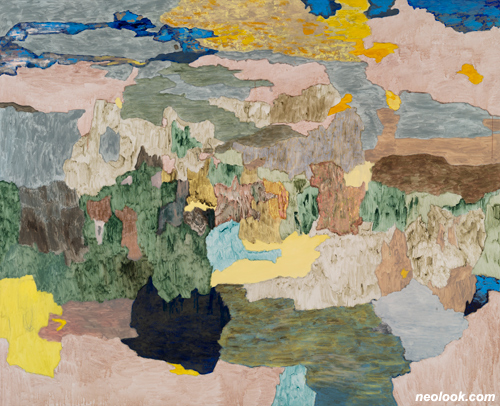
- 안드레아스 에릭슨_세마포어 지리산_캔버스에 유채, 아크릴채색, 템페라_195×240cm_2019 Andreas Eriksson_Semaphore Jirisan_Oil, acrylic, egg-oil tempera on canvas_195×240cm_2019
4. 자연 ● 안드레아스 에릭슨(b. 1975, 스웨덴 비외르세터)은 스웨덴 메델플라나 인근 시네쿨러 산에 머물며 작업한다. 자연 속에서 마주하는 다채로운 서사가 작업의 소재가 된다. 에릭슨의 작품세계는 서로 긴밀한 관계를 맺으며 자라난다. 회화에서 출발하여 조각, 판화, 직조 등의 매체로 나아간다. 「세마포어 지리산」(2019)은 추상적이고도 견고한 구성이 두드러지는 회화다. 하나의 드로잉을 소재로 제작한 연작에 '세마포어'라는 이름을 붙였다. 선박과 육지 사이 통신에 사용하는 국제 수기신호를 가리키는 용어다. 자연의 색채와 질감을 참조하지만 실제의 모습을 묘사하지는 않는다. 방문한 적 없는 한국의 지리산을 스웨덴 숲 속 자연에 투영하여 그린 그림이다.
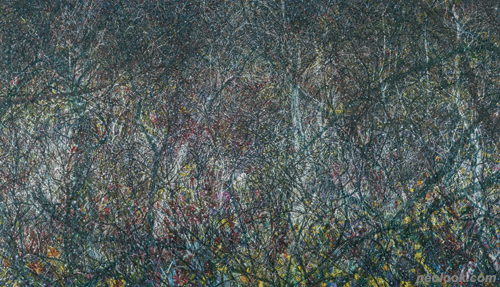
- 허수영_숲 10_캔버스에 유채_248×436cm_2016 HEO Suyoung_Forest 10_Oil on canvas_248×436cm_2016
허수영(b. 1984, 서울)도 자연을 그린다. 회화적 표현을 가장 자유롭게 드러낼 수 있는 소재라고 생각해서다. 자연은 단편적인 장면으로 단정하기 어려운 대상이다. 그렇기에 그리는 이의 자율성을 두루 포괄할 수 있다. 「숲 10」(2016)은 500호 두 폭으로 이룬 대형 회화다. 시간의 흐름에 따른 풍경의 변화를 하나의 화면에 중첩한 결과물이다. 장재민(b. 1984, 경상남도 진해)의 「뜻밖의 바위」(2015)는 보다 직관적인 표현을 선보인다. 장면 속에 머물며 경험을 수집하고, 순간적 선택에 따라 화면을 채워 나간다. 풍경의 고정된 의미를 지우고 오직 감각에 집중한다. ● 새삼 돌아본다. 생명에 대한 불안이 본질을 일깨운다. 자연에서 태어난 몸이 정신을 지니고, 물질을 개발하여 스스로 지켜냈기에 여기까지 왔다. 나은 삶에 대한 바람으로부터 예술도 탄생했다. 가까운 미래에 우리는 일상을 되찾을 것이다. 낯선 삶에 적응하여 또 다른 창작을 시도할 테다. 이전과는 다른 화면이어야 한다. 그래야 지금이 의미 있다. 철학자 조지 산타야나(1863-1952, 스페인)가 말했듯 "예술가는 현실에 대해 꿈꾸기로 한 몽상가다." 오늘을 사유하는 내일의 예술을 상상해 본다. 그리고 되새긴다. 견딜 수 있는 체온은 겨우 38℃. 열꽃 너머 뜨거운 예술은 우리를 품어 안은 세상으로부터 온다. ■ 박미란
Hakgojae Collection ● 38°C Humanity is ill. The disease that came abruptly proliferated at a terrifying pace and gave rise to the pandemic, unprecedented in this century. The dystopia in 2020 derived from a small virus of the real world, not extraterrestrials or robots, nor a theological being. The origin is unclear, but what is certain is that this unwelcomed visitor is already a part of the world that we will endure. Disease respects no privileges. The human body is feeble; it easily heats up when an unknown virus infiltrates. Thus, the temperature became a sign of infection. The standard for high fever is approximately 38°C, entrance to public spaces is restricted for those whose body temperature exceeds it. ● People worldwide are focusing on the body - people isolate themselves to protect it, and sensitively react to symptoms. With limits on physical activities, virtual reality has expanded. As time spent alone increased, interest in the inner world grew as well. We, who have been tirelessly chasing individual values, all together came to a stop. Only now, we look around our surroundings. The dangerous temperature, 38°C, is also the most comfortable bath water temperature one feels. Suddenly, we are humbled as minuscule beings in an immense world. Envision the environment with infinite bounds and depth that has been embracing the human body. This exhibition's objective is to contemplate the relationship between humanity and the world anew, using the pandemic era as an opportunity. Centering around the Hakgojae collection, this exhibition scopes on both Korean and international contemporary artists' works in four categories; body, mind, matter, and nature.
1. Body ● Lee Woosung (b. 1983, Seoul) paints portraits of the generation he belongs in. Depending on the set point of view, the bodies in the picture screen fluidly cross over the individual and social domains – forthright yet metaphoric, nonchalant yet tenacious. Fire, which appears in My Dear (2017), was the usual subject matter that embodied anxiety and helplessness in Lee's early paintings. A small flame, unextinguished, burns inside the palm. Tim Eitel's (b. 1971, Leonberg, Germany) picture screen reflects modern people's solitude and alienation. Anonymous figures saunter within geometric structures and refined colored backgrounds. Stadien (Arenas) (2001) consists of 12 canvases. Each picture screen depicts an empty arena. Two lone figures are in each canvas on either end. The figures' tied hands behind their backs hints at the absence of will to participate in the match. It may be due to fear, or perhaps, negligence. The viewer projects their own narrative to the picture screen; the empty spaces leave room for contemplation.
2. Mind ● The vibrant red lines outpouring from Kubi Series (2006) by Anish Kapoor (b. 1954, Mumbai, India) stretch towards the mysterious realm of darkness. Kapoor's red is the core of human interiority. 'Kubi' refers to the Brahmaputra River's headstreams, located in the Himalayas of southwestern Tibet. The river flows through the Assam region in India and then merges with the Ganges River from its source. The painting abstracts the mutual connection between human society and mind by implying it to a geographical concept. Giuseppe Penone (b. 1947, Garessio, Italy) is a central figure of 'Arte Povera,' an Italian avant-garde art movement. He explores the inner world using trees and the forest. There are three fingerprints that appear in Propagazione (1994). The form of concentric rings around the fingerprints connotes the pulse of life.
Park Gwangsoo's (b. 1984, Cherwon, Korea) picture screen integrates landscapes' and figures' form to enter a world of fantasy. The shallow yet definite layers of the gaze emerge in Depth – Valley (2019). The scattered lines form an obscure scenery, and the murky fog extends the depth, like a border between dream and reality, or consciousness and unconsciousness. Chen Wenji (b. 1954, Shanghai) materializes geometric picture screens using observations and contemplations of the world as his subject matter. Breath In, Breath Out (2007) is a painting that consists of six circular canvases painted in blue. The canvases, descending, and ascending with their own height, create a picture screen that feels as if it is breathing.
3. Matter ● Untitled (1995) by Ian Davenport (b. 1966, Kent, U.K.) is a painting created through a technique in which paint in a syringe is poured on to the picture screen. Davenport was "mesmerized by how the simplest tool brings about the most complex outcome." The colors, planned to flow in a specific direction and order, sometimes cross over or diffuse. The picture screen does not entirely control matter, and accepts the coincidental effects that occur under certain situations. Kim Hyunsik (b. 1965, Sancheong, Korea) utilizes epoxy resin, an industrial material, in painting. Repeating the process of finely scraping and hardening the surface of the material, he creates a sculptural flat surface. The light and shadow in the picture screen manifests a sense of depth in the flat surface and induces a meditative atmosphere.
4. Nature ● Andreas Eriksson (b. 1975, Björsäter, Sweden) lives and works on Mt. Kinnekulle, located near Medelplana in Sweden. Various narratives that the artist faces in nature are the subject matter for his works. Eriksson's oeuvre develops by forming intimate relationships with one another. Beginning from painting, his works expand to sculpture, print, weavings, etc. The abstract yet solid composition is prominent in his painting, Semaphore Jirisan (2019). He titled a series based on a single drawing as 'Semaphore,' a term for the international flag signal used between ships and shores. Although he refers to colors and textures from nature, the painting does not represent the actual landscape. Eriksson painted the Korean mountain that he has never visited, projecting it to the Swedish forest's nature.
Heo Suyoung (b. 1984, Seoul) also paints nature because he believes that it is the subject matter that allows him to manifest malerisch expressions most freely. Nature is brutal to predicate into fragmentary scenes. Thus, it can encompass the painter's autonomy extensively. Forest 10 (2016) is a large-scale painting consisting of two size 500 (approximately 248x218cm) canvases. It is the outcome of overlapping a landscape's transformations through the flow of time onto one picture screen. Unexpected Rock (2015) by Jang Jaemin (b. 1984, Jinhae, Korea) manifests a more intuitive set of expressions. Jang collects experiences while staying within a scenery and fills in the picture screen according to instantaneous decisions. He erases the fixed meaning of the landscape and solely concentrates on the senses. ● I abruptly look back. The anxiety for life enlightens the essence. We came to this moment, as the birthed body possessed the mind, and developed matter to protect ourselves. Art also emerged from the desire for a better life. We will regain our ordinary lives in the near future. We will certainly adapt to this unfamiliar life and attempt new creations. It must be a different picture screen from before. Only then, the present has significance. "An artist is a dreamer consenting to dream of the actual world," philosopher George Santayana (1863-1952, Spain) once said. I imagine the art of tomorrow that contemplates today. Then I ruminate on it. 38°C, the temperature one can barely endure. Fervent art, beyond scarlet fever, comes from the world that embraces us. ■ Miran Park
Translated by: Yoonsung Cho
Vol.20210106c | 38˚C : 학고재 소장품 Hakgojae Collection展
